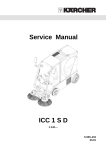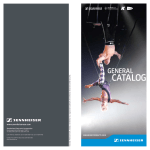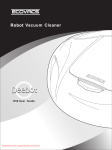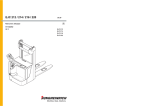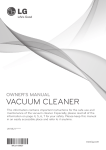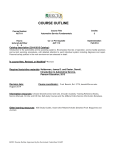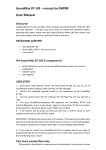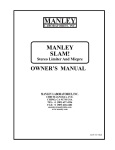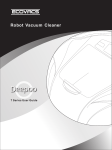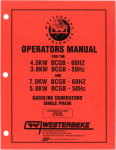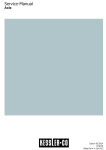Download User Manual Apex 62B
Transcript
User Manual Apex 62B Introduction Preface Dear customer, It is our desire that the good characteristics of the Apex 62 B should justify the confidence you demonstrated by making this purchase. Prior to the first drive, carefully read the chapter "Safety Information” as well, in order to ensure you a safe working with the machine. Your own safety, as well as the safety of others, depends to a great extent on how the vehicle is moved and operated. Therefore, carefully read and understand this operation and maintenance manual prior to the first drive. The manual provides valuable information about operation, service and maintenance. The warning symbols as used in this manual identifies items relevant to safety. Please observe the safety provisions (see chapter "Safety Information”). Your authorised PowerBoss dealer will be pleased to answer further questions regarding the vehicle or the operation and maintenance manual. 2 Please be advised explicitly that we cannot accept any legal issues out of the contents of this manual. If repair work has to be performed make sure that only genuine spare parts are used; only genuine spare parts may guarantee a dependable machine. We reserve the right for technical improvement.. Valid as of: July 2007 PowerBoss Inc. 175 Anderson Street Aberdeen NC 28315 U.S.A. Telephone: (910) 944-2105 Fax: (910) 944-740 Proper use The Apex 62 B sweeper has been exclusively designed for collecting dry and moist matter from floor surfaces in e.g. factories, storage buildings, parking grounds and pedestrian areas. Using the machine beyond this scope of application will be deemed improper use; The manufacturer cannot be held liable for consequential damages; the user alone bears the risk. The Apex 62 B is not suitable for collecting toxic, combustible or other matters which are hazardous to health. The term of proper use also includes operation, maintenance and repair work to be performed in compliance with the manufacturer's specifications. The Apex 62 B may be used by persons only that are familiar with the machine and aware of possible hazards involved. The applicable Accident Prevention Regulations and further regulations in vigour concerning aspects of safety and working medicine will have to be complied with. If modifications to the machine are made in absence of the manufacturer's prior consent, the latter cannot be held liable for damage resulting from such unauthorized modification. Introduction Notes on warranty The terms of the sales contract apply. Damages are not subject to warranty if they are due to non-compliance with the maintenance and service provisions. The maintenance work has to be performed by an authorized PowerBoss service center and confirmed in the "Maintenance certificate" which is the warranty document. The following is excluded from warranty: fuses, natural wear, damages caused by overload, inexpert handling and unauthorized modification of the machine. Moreover, any claim for warranty cannot be accepted if damages of the machine are caused by fitting parts or accessories without PowerBoss's prior and explicit consent or by noncompliance with the maintenance instructions. Acceptance of the machine Upon arrival, check machine for possible damages in transit. For refund of such damage, have the Deutsche Bahn AG or your freight forwarder confirm such damage. Mail notification and waybill to: PowerBoss Inc. 175 Anderson Street Aberdeen NC 28315 U.S.A. Telephone: (910) 944-2105 Fax: (910) 944-740 [email protected] 3 Table of Content Introduction . . . . . . . . . . . . . Preface. . . . . . . . . . . . . . . . . . Proper use . . . . . . . . . . . . . . . Notes of warranty . . . . . . . . . . Acceptance of the machine . . 1 1.1 1.2 1.3 1.4 1.5 1.6 1.7 2 2.1 2.2 2.3 2.4 2.5 2.6 2.7 2.8 4 2 2 2 3 3 Safety information . . . . . . . . 5 Safety and Warning Symbols . 5 General Provisions . . . . . . . . . 6 Provisions for Operation. . . . . 6 Maintenance instructions . . . . 8 Specific Hazards . . . . . . . . . . 9 Information for Protection of Environment . . . . . . . . . . . . . . . 10 Labels at the Machine . . . . . 11 First Operation . . . . . . . . . . 15 Instruction. . . . . . . . . . . . . . . 15 Initial charging procedure . . . 15 Before Taking into Operation 15 Start Machine . . . . . . . . . . . . 15 Operation . . . . . . . . . . . . . . . 16 Machine stopping and parking . . . . . . 16 After work . . . . . . . . . . . . . . . 16 Transport rides and Towing . 17 3 3.1 3.1.1 3.1.2 3.1.3 3.1.4 3.2.2 Operation . . . . . . . . . . . . . . Working Procedure . . . . . . . Sweeper Roller. . . . . . . . . . . Side Broom . . . . . . . . . . . . . Steering . . . . . . . . . . . . . . . . Filter System Dust Evacuation . . . . . . . . . . Shaking System . . . . . . . . . . Brake . . . . . . . . . . . . . . . . . . Travel Drive Assembly . . . . . Hydraulic System . . . . . . . . . Operating Elements . . . . . . . Control Panel Apex 62 B. . . . . . . . . . . . . . . Emtying of the Dirt Hopper. . 4 Technical Data . . . . . . . . . . 30 3.1.5 3.1.6 3.1.7 3.1.8 3.2 3.2.1 5 5.1 18 18 19 19 19 20 20 21 21 21 22 24 28 Maintenance and Care . . . . 34 PowerBoss System Maintenance . . . . . . 34 5.2 Maintenance document . . . . 35 5.3 Maintenance Schedule. . . . . 36 5.4 Battery System. . . . . . . . . . . 41 5.4.1 Low Discharge Signal Sender . 42 5.4.2 Battery Charging Status 5.4.3 5.4.4 5.4.5 5.4.6 5.5 5.5.1 5.5.2 5.5.3 5.5.4 5.5.5 5.5.6 5.6 5.6.1 5.6.2 5.6.3 5.6.4 5.7 5.8 5.9 Indicator . . . . . . . . . . . . . . . . 43 Hourmeter . . . . . . . . . . . . . . 43 Setting Other Battery Types. 43 Plug Connection Coding . . . 44 Batterie einsetzen . . . . . . . . 46 Sweeper Unit . . . . . . . . . . . . 48 Mount/Dismount Sweeper Roller. . . . . . . . . . . 48 Adjust Sweeping Track . . . . 49 Sealing Strips for Broom Compartment . . . . . . 50 Replace Side Broom . . . . . . 50 Dismount Plate Filter . . . . . . 51 Basic Cleaning of Plate Filter 52 Hydraulic System . . . . . . . . . 53 Check Hydraulic Fluid Level . . . . . . . . . . . . . . 53 Refill Hydraulic Fluid . . . . . . 54 Change Hydraulic Filter . . . . 54 Change Hydraulic Fluid . . . . 55 V-Belt Drive Apex 62 B. . . . . . . . . . . . . . . 56 Electric System Apex 62 B. . . . . . . . . . . . . . . 57 Special Equipment and Spare Parts . . . . . . . . . . . . . 59 Safety information 1 Safety information 1.1 Safety and Warning Symbols All paragraphs in this manual referring to your personal safety, the safety of your machine and the environment protection are attributed one of the following warning symbols: Symbol Hazardous for ... Description Safety Provisions persons and goods Safety Provisions in dangerous situation caused by misuse inaccurate adherence of instructions or prescribed work routine. CAUTION the machine important information on handling the machine in order to maintain operability. Ecological hazard the environment due to use of substances representing an inherent danger to health of environment 5 Safety information 1.2 General Provisions • Apart from the provisions contained in this instruction manual, the general safety provisions and the accident prevention regulations as imposed by law have to be complied with. • Before taking your machine into operation, carefully read the instruction manual and comply with all points mentioned there during work. • Persons being trained by qualified PowerBoss technicians only are authorised to operate, service and repair the machine. • You are advised to thoroughly study the safety instructions since precise knowledge only helps avoiding errors during operation of the machine and thus guarantee faultless usage of the machine. • The operating instructions have to be at hand at the place of use of the machine, and therefore have to be kept readily available at the machine. • When selling or letting the machine for rent, hand out these documents to the new owner/operator and have the transfer certified! 6 • The warning and instruction plates attached to the machine contain valuable advice about safe operation. Immediately replace incomplete or illegible labels. • As far as safety standards are concerned, spare have to equal genuine spare parts! • Keep clear of hazard zone of the Apex 62 B. • Only use a mobile phone when the machine standing still. • Passenger transport is not admitted. 1.3 Provisions for Operation • Before taking into operation, check the machine for operational safety! Immediately remedy malfunctions! • It is indispensable for the operator to get acquainted with all attached implements and controls as well as with their function before operation begins. Once you have started to work, no time will be left to do so! • When working with the machine use firm and skid proof shoes. • The machine may be used only on such surfaces clearly specified by the owner or his authorised representative. • When working with the machine take notice of third persons, especially children. • The machine is not designed for collecting hazardous, inflammable or explosive dusts or substances. • This machine must not be used as dust-evacuating machine with dust filter insert (separator) to collect dusts which are hazardous to health. • Usage of the machine in explosive areas is prohibited. • Pull the key switch to avoid unauthorized use of the machine. • Before commencing work, the operator has to make sure that the machine and its accessories are in proper and safe condition. Machines with known defects must not be used. • Before operation of the machine, adjust driver's seat such that complete visibility of the riding track and the rear working area is given! • For safety reasons, the driver's seat is equipped with a seat contact switch. Function of this contact switch must not be bypassed! • The seat contact switch will controlled electronocally. Any manipulation Safety information • • • • • to result in automatically blocking of the machine. Disengage all drive systems before switch-on the machine. The machine may be started, run and stopped by a person seated only. Never let the machine run in indoor areas! Intoxication hazard! Provide for sufficient ventilation when sweeping indoors (dust and combustion gas). Intoxication hazard! Always adapt the driving speed to the ambient conditions and the loading state. Compared to four-wheeled vehicles, driving stability of three-wheeled vehicles is reduced, therefor: Abrupt steering manoeuvres at higher speed or negotiating curves at high speed may cause tipping of the articulated vehicle. Do not turn at slopes but on level ground only Ride up- and downhill straight. Avoid taking sudden curves when riding up- or downhill or across to the slope. In slope there is tilting danger. • The machine may be used only for operation on areas with a maximum inclination of up to 16 %. • Do not exceed the admissible total weight and the admissible axle load limits. Check the dirt hopper filling level frequently. • Before lifting or lowering the dirt hopper make sure that no persons, animals or other obstacle are in the area of operation. • Pinching and shearing hazard. Provide for required safe distance before lifting or lowering the dirt hopper. • It’s only allowed to lift up the dirt hopper in immediately nearness of the container. Emtying the dirt hopper on level and solid ground. • Do not sweeping when the dirt hopper is lifted. • By emtying the dirt hopper pay attention to bystanders. • Proceed to filter shaking only if the dirt hopper is in closed position. • Pay attention to hot parts for example cooling water, tubes of the exhaust etc.. 7 Safety information 1.4 Maintenance instructions • The daily and weekly maintenance and repair task must be performed by a qualified operator. For any maintenance and repair work beyond please contact your local PowerBoss service centre. • Observe the maintenance activities and intervals set out in the instruction manual. • Maintenance and repair work may be carried out only by means of appropriate tools. • Have the machine checked for safe condition in the sense of the Accident Prevention Regulation by an expert at regular intervals (recommendation: at least once yearly) as well as after modifications or repair. • Spare parts have to equal the technical requirements as specified by the manufacturer! Genuine spare parts guarantee compliance with these requirements. • Use of other than the sweeper rollers and side brooms approved by the manufacturer is not admitted (see technical data) since use of other sweeper rollers and side brooms may affect your safety. 8 • Use of other than the oilfilters approved by the manufacturer is not admitted (see technical data) since use of other air- and oilfilters may affect your safety. • Stop machine before proceeding to inspection and maintenance work. Pull the key. • Proceed to cleaning of the dirt hopper in regular intervals to preclude formation of bacterial deposits. • The machine is splash-proof (IPX3). Cleaning the machine by means of high-pressure cleaning equipment or by vapour jet is prohibited. • Turn off the machine before transporting them. • After having jacked the Apex 62 B by means of a car lifter, additionally support the machine adequately. • No person is allowed to be in the jakked or lifted-up Apex 62 B. • Before changing wheels protect the machine against rolling by placing wedges. Proceed to wheel changing when the machine is on level and solid ground. • Do not remove, install or repair a tire on the rim. Contact a tire workshop for works at tires and rims. Such • • • • • • • workshops have qualified personnel as well as special safety tools at disposal. Do not proceed to welding, boring, sewing or grinding at the vehicle's frame. Only PowerBoss-workshops are authorized to replace damaged parts. Use genuine fuses only.Use of higher-level fuses may damage the electric system. Risk of fire. When working at the electric system disconnect the the battery plug. Do not keep batteries discharged for a longer period, always recharge them as soon as possible. Top with distilled water only. Never refill battery acid in battery cells of perfect condition. Keep batteries dry and clean and clear of soiling such e.g. metallic dust to avoid leakage current. Battery acid is highly caustic (keep clear of children). When checking the battery acid level, wear safety glasses. If acid splashes get into the eyes rinse with clear water for 15 minutes and contact a doctor immediately. Use appropriate protective means Safety information • • • • • (e.g. protective gloves or fingerstalls) when handling battery acid. Do not use open flames (explosion hazard). Pinching and shearing hazard by fitting, removal and change of the battery. All liquids escaping under high pressure (such as e.g. hydraulic liquid) may penetrate the skin and cause heavy injuries. Contact a doctor immediately in order to avoid infections. Take all precautions before draining boiling oil - burning hazard. Inspect the braking system at regular intervals. PowerBoss-workshops or approved brake service centres only are authorized to proceed to adjustment or repair work of the brake system. Inspect the hydraulic system at regular intervals. PowerBoss-workshops only are authorized to proceed to adjustment or repair work of the hydraulic system. Check hydraulic hoses and lines for leakage or damages in regular intervals. Replace defective hoses and lines immediately. 1.5 Specific Hazards Safety equipment • Do not operate the Apex 62 B without safety equipment being installed (all cover parts of the machine). Elektric system • Only use genuine fuses with prescribed connecting load. • In case of malfunction of the electric system, immediately shutdown machine and remedy. • Qualified personnel only is authorised to proceed to works at the electrical equipment and only according to electro-technical rules. • Inspect/check the electrical equipment of the machine at regular intervalls. Immediately remedy defects such e.g. loose connections or scorched cables. • Respect the operating instructions of the battery manufacturer. • Never place metal objects or tools on batteries - short-circuit hazard! • Provide for sufficient ventilation of areas where batteries are charged. – Explosion hazard! Open seat hood by loading the batteries. 9 Safety information 1.6 • • • • • • 10 Information for Protection of Environment For safe use of substances inheriting a danger to health and environment specific knowledge is required. During maintenance and repair, all ope-rating media have to be collected In adequate receptacles. Provide for disposal in compliance with the legal provisions according to the Waste Disposal Act and the Used Oil Act. Do not let leaking oil, lubricants or other substance penetrate the soil. Danger of ground water soiling. Wipe away spilled fluids and provide for disposal according to the regulations. Depending on the filtered substances, used filter inserts are considered special waste in most cases and have to be disposed of accordingly. Batteries contain highly caustic sulphuric acid. Batteries have to be handled with utmost caution. Old batteries are considered special waste and have to be disposed of accordingly. Used batteries labelled as recyclable contain reusable economic goods. According to the crossed dustbin label these batteries must not be added to the normal waste. Provide for agreement with the PowerBoss contract dealer on return and disposal according to § 8 BattV. Safety information 1.7 Labels at the Machine The following safety and information labels are legibly attached to the vehicle. Replace missing or illegible labels immediately. Key switch (Fig. 1/4) High-pressure cleaner Steam cleaner (Fig. 1/8) PowerBoss nameplate front (Fig. 1/1) and rear (Fig. 2/1) Brake (Fig. 1/5) Lifted-up disposal function (Fig. 1/9) Vehicle identification number (Fig. 1/2) Parking brake (Fig. 1/6) Instruction manual (Fig. 1/3) Folding apron (Fig. 1/7) 11 Safety information Pinching hazard (both sides) (Fig. 2/2) Sound power Rise (Fig. 1/10) Hydraulic fluid (Fig. 2/5) Type name (Fig. 2/6) Sweeper roller wearing take-up (Fig. 2/3) Adjust sweeping track side broom (Fig. 1/11) Rotating parts (Fig. 2/4) Maximum speed (Fig. 1/12) and (Fig. 2/ 7) (option) 8 12 Apex 62 B Safety information 9 10 12 12 1 11 7 5 2 6 4 3 8 Fig.1 13 Safety information 1.8 6 3 2 4 1 4 7 5 Fig.2 14 First Operation 2 First Operation 2.1 Instruction Instruction is required before first operation. First instruction into handling of the machine must be held by a qualified person sent by your local PowerBoss contract dealer. Your PowerBoss dealer will be informed by the manufacturer upon delivery of the vehicle and will contact you to make a date for instruction. 2.2 Initial charging procedure Before first operation of the machine, fully charge the battery with an initial charging procedure and comply with the operating instructions of the charger as well as with those of the battery manufacturer. PowerBoss cannot be held liable for damages resulting from the fact that the initial charging has not or insufficiently been done. 2.3 Before Taking into Operation Proceed to the following inspections before taking the machine into operation: 1. Check parking site for signs of leakage. Hoses, lines and tanks must be free from any leakage or damage. 2. Open seat hood. 3. Check charge of battery and charge if required. 4. Close seat hood. 2.4 Start Machine Before starting the machine you are advised to read and comply with the Provisions of Operating from Safety Information chapter! Before starting the machine, subsequently actuate the following control elements: 1. Set all operating levers and switches to neutral. 2. Secure the vehicle by engaging the parking brake. 3. Turn key switch and start machine. - After the machine has switched on, the charge control display (TSG) is lighting up by full charging battery. Do not use the Apex 62 B at ambient temperatures of more than 40°C. Do not switch on the machine at temperatures of 0°C or less. Its not possible to switch on the machine, when the accelerator pedal is linked. 15 First Operation 2.5 Operation Proceed to the following to set the machine into operation: 1. Check the machine, see paragraph 2.3 - Before Taking into Operation. 2. Start vehicle, see paragraph 2.4. In initial position, vacuuming is activated. Use the operating draw if the collected dirt is wet. 3. Lower sweeper roller and side broom. 4. Release parking brake. 5. Slowly depress drive pedal until desired speed has been attained. 6. Check filling level of the dirt hopper and emty if required. 7. Operate shaking installation regular for cleanig the filter. 16 2.6 Machine stopping and parking 1. Release drive pedal which returns automatically in neutral position and the machine slows down. 2. Actuate parking brake. 3. Lift sweeper roller and side broom. 4. Switch machine off. Slowing down the Apex 62 B is possible by applying opposite forces with the drive pedal or by using the service brake. When leaving the machine unattended, pull key switch in order to preclude unauthorized use. 2.7 After work 1. Ride machine to suitable site for cleaning. 2. Stop machine, lift sweeper roller and side boom. 3. Start shaking procedure. 4. Empty dirt hopper, see operation chapter 3.2.2. 5. Clean machine. Do not clean the electrical parts by means of high-pressure cleaning equipment. First Operation 2.8 Transport rides and Towing Transport rides Before transporting the Apex 62 B on other vehicles, engage the parking brake and secure the machine by placing wedges at the wheels and by straps on the tie-down points front (Fig. 3/1) and rear (both sides) (Fig. 3/2). For safety reason, by activated machine and by leaving the driving seat is resounding a warning signal. Towing Lift up the front wheel when towing the machine. 2 1 Fig.3 17 Operation 3 Operation 3.1 Working Procedure General The Apex 62 B sweeper has been exlusively designed for collecting dry and moist matter from floor surfaces in e.g. factories, storage buildings, parking grounds and pedestrian areas. 4 Functional Description The side broom (Fig. 4/1) is used to collect dirt at corners and borders and to enlarge the working width as well as to increase the area performance on large surfaces. The sweeper roller (Fig. 4/2) casts the dirt overhead into the dirt hopper (Fig. 4/3). The collected fine dust is evacuated by the suction fan and separated by a filter system (Fig. 4/4). The air returned into the environment is clean. Dirt disposal at the Apex 62 B is realized via lift-up disposal (lift-up hight>1420mm) directly into standard waste container. 1 Fig.4 18 2 3 Operation 3.1.1 Sweeper Roller The sweeper roller (Fig. 4/2) is equipped with 12 rows of bristles arranged in v-shape. The sweeper roller width amounts to 800 mm and its diameter to 430 mm. The operator lifts and lowers is by hand lever (Fig. 5/1). 4 1 3 3.1.2 Side Broom The standard version, the side broom (Fig. 5/2) is located at the front right of the machine.The operator lifts and lowers is by hand lever (Fig. 5/3). The swinging area of the side broom arm is limited by stops. For special application, fitting of a second side broom at the left side is possible. 3.1.3 Steering Steerage is effectuated mechanically from steering wheel to front wheel via chain. This chain is to be re-adjusted as required. 2 Fig.5 Any work at the steering has to be executed by authorized PowerBoss-service-workshop only. 19 Operation 3.1.4 Filter System Dust Evacuation The filter system is located in the filter case (Fig. 6/1) above the dirt hopper (Fig. 6/2). The suction fan transports the fine dust raised by the sweeper roller to the plate filter (Fig. 6/3) where it is separated. The fine dust sets at the outside of the filter blades. 1 In case of heavy dusty sweeping dirt, check and clean the plate filter (Fig. 6/3) at regular intervals. 3 3.1.5 Shaking System Due to normal working vibration the set dust from the plate filter (Fig. 6/3) partly falls off into the dirt hopper (Fig. 6/2). To ensure working in a dustfree ambiance, actuate the shaking system regulary, or after request by the control lamp (Fig. 10/5) at the latest. 2 Fig.6 20 Operation 3.1.6 Brake The Apex 62 B is equipped with a service brake. This brake has been constructed as shoe brake and equally serves as parking brake. It is located in the rear wheels and is actuated via cables. Two special adjustment screws (Fig. 7/2) are located in front of the chassis, behind the front cover (Fig. 7/1). 3 Any work at the braking system has to be executed by authorized PowerBoss-service-workshop only. 3.1.7 Travel Drive Assembly The Apex 62 B are equipped with a electric drive assembly. 1 3.1.8 Hydraulic System The hydraulic system existing of hydraulic valves, hydraulic pump with hydraulic fluid tank (Fig. 7/3) and serves the operation of the lifted-up disposal and the suíde broom. 2 Fig.7 21 Operation 3.2 1 2 3 4 5 6 7 8 Operating Elements Actuator for folding apron Service brake lock Service brake / parking brake pedal Drive pedal, reverse Drive pedal, forward Control panel Seat adjustment Lever for dirt hopper (lifting-lowering-swinging) 6 6 7 5 3 Fig.8 22 2 1 8 4 Operation Actuator for folding apron (Fig. 8/1) To open and close the folding apron for collecting coarse dirt during sweeping drive. Drive pedal, reverse (Fig. 8/4) To change direction to reverse ride with contineous regulation of riding speed at the same time. If the driver releases the pedal it returns to initial position and the machine slows down to standstill. Service brake / parking brake lock (Fig. 8/2) To lock the service brake / parking brake. Operate pedal and fix with lock. The service brake is working then as parking brake. The lock released by pushing service brake pedal (Fig. 8/3). Control panel (Fig. 8/6) Refer to chapter „Control Panel“. Service brake / parking brake pedal (Fig. 8/3) Serves for operating the sevice brake on the rear wheels. Simultaneously actuate service and parking brake before leaving the machine. Seat adjustment (Fig. 8/7) To adjust the seat position to drivers of different height. Adjust the seat so as to allow the driver being comfortably seated and attaining all elements required for operation. - Adjust seat lengthwise: push lever slightly to the right and displace seat forwards or backwards to the required position. Then let the lever catch again. Drive pedal, forward (Fig. 8/5) To change direction to forward ride with contineous regulation of riding speed at the same time. If the driver releases the pedal it returns to initial position and the machine slows down to standstill. Lever for dirt hopper (Fig. 8/8) (lifting-lowering-swinging) Lever for lifting-lowering-swinging the dirt hopper. For lifting and lowering pull simultaneously lever for release of lifted-up disposal function (Fig. 9/1). Swinging follows without operating of the lever (Fig. 9/1). Simultaneously actuate lever for release of lifted-up disposal function, lever for sweeper roller (see chapter „Control Panel“), he serves releasing the dirt hopper for lifting and lowering. Swinging of the dirt hopper without lever for release for lifted-up disposal function. 23 Operation 3.2.1 Control Panel Apex 62 B 1 Sweeper roller lever and release of lifted-up disposal function 2 Side broom lever or rather for side broom and sweeper roller 3 Suction fan / shaking system knob 4 Control lamp, shaking system 5 Control lamp, direction indicator (Option) 6 Hourmeter / Charge control display (TSG) 7 Control lamp, parking brake 8 Horn 9 Key switch 10 Indicator lever (Option) 11 Lighting (Option) 12 Warning light (Option) 13 Rotating beacon (Option) 14 Side broom left (Option) 6 2 1 7 4 5 10 8 11 14 13 12 3 9 Fig.9 24 Operation Sweeper roller lever and lifted-up disposal (Fig. 9/1) Two-Hand-Operation. For lifting, lowering, swinging, to switch on and off the sweeper roller and to release of lifted-up disposal. - Sweeper roller lowering and switch on = push lever - Sweeper roller lifting and switch off = pull in middle position - Release of lifted-up disposal function = pull lever (see chapter „Emtying of the Dirt Hopper“). Lifting and turn off the sweeper roller, if the lever for the right side broom is in lifting position. Side broom lever (Fig. 9/2) To lift and lower the side broom or lower and turn on the side broom and sweeper roller in one process (Fig. 9/1). - Lower side broom = push lever. - Lift side broom = pull lever. Suction fan / shaking system (Fig. 9/3) Knob position (from bottom to top): 0 Activated vacuuming function 1 Deactivated vacuuming function 2 Shaking system ON (pull knob to stop and then release) If the yellow control lamp (Fig. 9/5) lights actuate the shaking system (position 2). In this position, the shaking system is operable and proceeds to jolting in 7 repeated intervals. 25 Operation After jolting, the knob is to be kept in position 1 for about 25 seconds. Control lamp, shaking system (Fig. 9/4) Proceed to jolting of the filter system upon lighting of this control lamp by actuating the knob (Fig. 9/4) in position 2. The control lamp flashes during the shaking procedure and extinguishes after filter has been cleaned. Jolting is effectuated in 7 intervals. 26 Control lamp, direction indicator (Option) ((Fig. 9/5) Indicate, if using the indicator lever, the direction. Hourmeter Charge control display (TSG) (Fig. 9/6) Indicates the operating hours. The counter works only if the driver is seated and the machine is running. Charge control display see chapter 5.4 Battery System. Control lamp, parking brake (Fig. 9/7) Lights upon actuation of the parking brake. Extinguishes upon release of the parking btake. Horn (Fig. 9/8) An acoustic signal sounds upon actuation of this button. Operation Key switch (Fig. 9/9) To switch on and off the machine and to secure it against unauthorised use. Warning light (Option) (Fig. 9/12) Use this switch by a technocal defect, if is impossible to move the machine. Lighting flashes ON/OFF. For safety reason, by activated machine and by leaving the driving seat is resounding a warning signal. Indicator lever (Option) (Fig. 9/10) Indicate changing of direction - Lever down = to left. - Lever up = to right. Side broom left (Option) (Fig. 9/14) For special application, fitting of a second side broom at the left side is possible. - Switch actuate = side broom lowering and turning on. Switch not actuate = side broom lifting and is laying up. Rotating beacon (Option) (Fig. 9/13) To switch the rotating beacon ON/OFF. Lighting (Option) (Fig. 9/11) To switch the driving headlight ON/ OFF. 27 Operation 3.2.2 Emptying of the Hopper Proceed to emptying of the hopper as follows: • Lift and switch off side broom and sweeper roller. • Proceed to shaking of the filter system. • Lift hopper as follows: Pull lever for hopper (Fig. 10/1) upwards and simultaneously pull the lever for sweeper roller and release for lifted-up disposal (Fig. 10/2) in arrow direction. • Bring hopper for disposal in suitable height position. • Back the Apex 62 B until the hopper is positioned above the container. • Pull lever for hopper (Fig. 10/1) in arrow direction, hopper is swinging in emtying position. • Forward the Apex 62 B after complete emptying. Caution by driving away, if dirt hopper is towering in the container: Hazard of damaging! 28 Fig.10 2 1 Operation • Lower hopper as follows: Pull lever for dirt hopper (Fig. 10/1) down and simultaneously pull the lever for sweeper roller and release for lifted-up disposal (Fig. 10/2) in arrow direction. • The hopper is swinging automatically in starting position by lowering. • Hopper is again in working position. The operation of lifted-up disposal function is blocked as long as sweeping function is ON. Do not switch on sweeper roller when hopper lifting out. Riding with the lifted hopper reduces stability of the machine significanty. For this reason, do not lift the hopper but just before emtying. Before lifting the hopper, the operator has to make sure that no persons or objects are behind or next to the machine. Stop the machine on level ground before lifting the hopper. When the hopper is lifted, the operator has to ride the machine slowly. Keep clear of the hazard zone! Pinching and shearing hazard. Provide for required safe distance before lifting or lowering the hopper. The hopper is approved only for max. filling of 130 litres but not more than a weight of 220 kg. Do not move the machine during the lifting procedure. Clean the hopper in regular intervals. 29 Technical Data 4 Technical Data Dimensions and weights Length with side broom Width without side broom Width with 1 side broom Width with 2 side brooms Height above driver’s seat Dead weight Admissible total weight Driving and sweeping performance Forward speed Reverse speed Sweeping speed up to (4 km/h recommended) Sweeping track w/o/with 1 side broom Sweeping track with 2 side brooms Theoretical sweep. perf. with 1 or 2 side brooms Theoretical sweep. perf. without side broom Gradability (max. 1 min) 30 mm mm mm mm mm kg kg 1998 1142 1142 1142 1520 735 1395 km/h km/h km/h mm mm m² / h m² / h % 0-8 0-4 8,0 800 / 1150 1470 9200/11700 6800 16 Technical Data Filter system Filtering surface Plate filter Sweeper roller Length / diameter Wearing limit Speed Sweeping track Quantity of bristle rows Serial bristling Ground clearance of sealing Sealing strips, left / right / rear Sealing strip, front Side brooms Diameter Speed Serial bristling m² peaces 5,0 1 mm mm 1/min mm 800 / 430 350 500+/-20 50+10 12 v-shaped PES mm 1/1/4 lying on the bottom mm 1/min 600 85+/-4 PES 31 Technical Data Debris hopper Hopper capacity litre 130 Drive wheels wheel front, solid rubber tires Wheel bandage: D=300/B=100 Solid rubber tires (rear) 4.00-8 Hydraulic system Travel drive assembly Haydraulic fluid, e.g. Mobiloil Hydraulic tank, capacity Fluid filter cartridge Electric system Supply voltage Drive (recirculated capacity) Drive of sweeper roller (recirculated capacity) Drive of side broom (recirculated capacity) Drive of exhaust fan (recirculated capacity) Degree of protection against infiltration of water 32 litre order-no. V KW KW KW KW DTE 15 M (or an equivalent oil) 13 01133510 24 1.875 1.25 1.25 1.25 IPX3 Technical Data Noise emission The sound pressure level (LpA) measured according to DIN IEC 60335-2-72 and under standard operating conditions at the operator’s ear amounts to: The sound power level (LwA) measured according to DIN IEC 60335-2-72 under standard operating conditions and maximum volume flow amounts to: dB (A) 71 dB (A) 88 33 Maintenance and Care 5 Maintenance and Care General Before proceeding to maintenance and care work you are advised to read and comply with the Safety Information chapter! Compliance with the recommended maintenance works will give you the certitude of always having a reliable machine at disposition. Daily or weekly maintenance and repair works may be executed by the driver/ operator having been trained accordingly. Further PowerBoss system maintenance works have to be executed by qualified personnel only. Please contact your local PowerBoss Service Centre or PowerBoss contract dealer. We cannot be held liable for damages resulting from non-compliance with these instructions. Please indicate the machine's serial number with any enquiry or spare part order, see paragraph 1.7 - Nameplate. 34 5.1 PowerBoss System Maintenance The PowerBoss System Maintenance: • guarantees reliable operability of the PowerBoss machines (preventive maintenance) • minimizes operating costs, repair costs and maintenance costs • ensures long service life and operability of the machine The PowerBoss System Maintenance is structured in separate modules and determines specific technical works to be executed as well as the intervals for such maintenance works. For any specific maintenance type, the replacement parts are determined and listed in spare part kits. PowerBoss-System Maintenance K: To be performed by the customer in accordance to the maintenance and care instructions contained in the operating instructions (daily or weekly). The driver/operator will be instructed upon delivery of the machine. PowerBoss-System Maintenance I : (after 50 hours of operation - einmalig) To be performed by qualified personnel of authorised PowerBoss Service Centre. PowerBoss-System Maintenance II: (every 125 hours of operation) To be performed by qualified personnel of authorised PowerBoss Service Centre in accordance with the machine-specific system maintenance including spare part kit. PowerBoss-System Maintenance III: (every 250 hours of operation) To be performed by qualified personnel of authorised PowerBoss Service Centre in accordance with the machine-specific system maintenance including spare part kit. PowerBoss-System Maintenance S: (every 500 hours of operation safety check) To be performed by qualified personnel of authorised PowerBoss Service Centre in accordance with the machine-specific system maintenance including spare part kit. Execution of all safety-relevant inspections according to UVVBGV-TÜV-VDE as prescribed by law. Maintenance and Care 5.2 Maintenance document Handing over Upgrade Test drive Handing over to the customer Instruction carried out on: PowerBossSystem-Maintenance I 50 operating hours PowerBossSystem-Maintenance II 125 operating hours PowerBossSystem-Maintenance III 250 operating hours Workshop stamp Workshop stamp Workshop stamp carried out on: carried out on: carried out on: at _________________ operatin hours at _________________ operatin hours at _________________ operatin hours at _________________ operatin hours PowerBossSystem-Maintenance II 375 operating hours PowerBossSystem-Maintenance III+S 500 operating hours PowerBossSystem-Maintenance II 625 operating hours PowerBossSystem-Maintenance III 750 operating hours Workshop stamp Workshop stamp Workshop stamp Workshop stamp carried out on: carried out on: carried out on: carried out on: at _________________ operatin hours at _________________ operatin hours at _________________ operatin hours at _________________ operatin hours PowerBossSystem-Maintenance II 875 operating hours PowerBossSystem-Maintenance III+S 1000 operating hours PowerBossSystem-Maintenance II 1125 operating hours PowerBossSystem-Maintenance III 1250 operating hours Workshop stamp Workshop stamp Workshop stamp Workshop stamp carried out on: carried out on: carried out on: carried out on: at _________________ operatin hours at _________________ operatin hours at _________________ operatin hours at _________________ operatin hours 35 Maintenance and Care 5.3 Maintenance Schedule PowerBossSystem Mainten. Customer The following maintenance works are to be performeded by the customer. Interval Discription of task daily 36 Check dirt hopper (dustbin), and empty if required o Operate shaking system o Test drive and function test o Maintenance and Care PowerBossSystem Maintenance Customer The following maintenance works are to be performeded by the customer. Interval Discription of task weekly Check acid level, fill up distilled water if required (by end of charge only) o Dirt hopper: Check sealing and replace if required o Check sweeper roller for wearing or foreign particles, re-adjust or replace if required o Check electrical system o Check hydraulic fluid level, refill if required o Check side broom for wearing, re-adjust and replace if required o Check folding apron for wearing and damaging, re-adjust and replace if required o Visual check of engine and hydrailic system for oil leakage o Clean machine o Test drive and function test o 37 Maintenance and Care PowerBoss-System Maintenance I The following maintenance works are to be performeded by authorized PowerBoss-Service-Centre. Interval Discription of task after 50 hours of operation (uniquely) 38 Check sealings at filter system o Visual check of V-belts o Check hydraulic fluid filter and refill fluid o Check optical condition of machine o Test drive and function test o Maintenance and Care PowerBoss-System Maintenance II The following maintenance works are to be performeded by authorized PowerBoss-Service-Centre. Interval Discription of task every 125 hours of operation Clean battery terminals o Check service/parking brake and re-adjust if required o Check hydraulic fluid level o Check sweeping track and adjust if required (main- and sidebrush) o Check brush apron and adjust if required or change o Check sealings at filter system o Check V-belt for wearing and correct tension and re-adjust if required o Basic cleaning of the plate filter o Check optical condition of machine o Test drive and function test o 39 Maintenance and Care PowerBoss-System Maintenance III The following maintenance works are to be performeded by authorized PowerBoss-Service-Centre. Interval Discription of task every 250 hours of operation 40 Perform maintenance works according to PowerBoss-System Maintenance II o Check tension of steering chain and adjust tension if required o Check tread of wheels o Change plate filter o Check lifted-up disposal function (2-hand-operation) o Check hydraulic hoses and replace if required o Check function of seat contact switch o Check cables and plugged connections for damages and tight fit o Check carbon brushes of the electric motor for free movement and wearing, cleanse of motor from coal dust and change carbon brushes if required (PowerBoss Service Centre) o Maintenance and Care PowerBoss-System Maintenance S (Safety check) The following maintenance works are to be performeded by authorized PowerBoss-Service-Centre at least once yearly. Interval Discription of task every 500 hours of operation Perform maintenance works according to PowerBoss-System Maintenance II and III o Change hydraulic fluid and filter o Check fixing screws (brake, steering wheel and lifted up disposal) and tighten if required (Safety check) o Check braking system (Safety check) o Check steering wheel (Safety check) o Test drive and function test of safety components o 41 Maintenance and Care 5.4 Battery System Befor commencing any work on the electric system disconnect the battery plug. Do not use open flames when handling batteries and especially when checking zhe battery acid level. Provide for sufficient ventilation in rooms where batteries are charged. Spilled (straight) battery acid must not get into the sewage system before having been neutralised. Comply with the regulations imposed by law and observe local prvisions. Open the hood before charging batteries; explosive gases may accur during the charging procedure. 42 Maintenance and Care 5.4.1 Low Discharge Signal Sender 3 1 4 2 5.4.2 Battery Charging Status Indicator Upon turning ON by key switch, battery charging status is shown by display of green bars (Fig. 11/1). As the battery discharge during operation, the lighting green bars extingguish one after another showing thus always the current charge status of battery charge. Flashing of the last two green bars (Fig. 11/3) indicates that operation will be stopped soon. In order to preclude low discharge of batteries, the sweeping units are switched off and riding speed reduced to 50% if battery is dischrage. The red LED (Fig. 11/4) than flashes 5.4.3 Hourmeter The operating hours of the machine appear in the display (Fig. 11/2); the hourmeter will count only during working or transport ride; only full hours are displayed. 5.4.4 Setting Other Battery Types Have the low discharge signal sender set to other battery types by qualified personnel only and in approved qualified workstations only. Fig.11 The factory setting is as follows: tray battery 420 Ah EPzS. 43 Maintenance and Care 1 Voltage coding is the same for all plugs and socket 2 Coding pin colour in the machine = yellow 3 Coding pin colour 5.4.5 Plug Connection Coding The battery plugs of the machine, the battery and the stationary charger unit have to be coded according to the battery type and the nominal voltage with coloured pins. The charger unit’s plugs are/will be coded in the factory according to the characteristics curve and changing the characteristic curve (according to the battery type ) always requires modification of the plug coding. Plug case of charger unit: - grey for wet batteries - green for maintenance-free Gel batteries Machine plug case: - yellow for both battery types Battery socket case: - grey for wet batteries - green for maintenance-free Gel batteries 44 Nominal voltage value for plug printed on each side of the hexagon (letters upside down) Inscription for nominal voltage for sockets accordingly Remove the coding pin by pressing the ends together by means of pliers. Press together for assembly. Insert pin such that the nominal voltage inscription is visible through the case window. Socket and plug always with the same nominal voltage. The following three requirements have to be met: Before first operation of the machine, the batteries have to be adequately charged by an initial charging procedure. Please observe the instruction of the charger unit’s operating manual. PowerBoss rejects any claim for warranty on battery damges caused by unfulfilled initial charging. Maintenance and Care 45 Maintenance and Care nect charger plug and device plug for electrical connection (Fig. 13/1) . 5.4.6 Batterie einsetzen • Turn engine off and pull key. • Secure machine by engaging the parking brake. • Fold back seat hood. • Insert batteries into the battery tray from the top. (Fig. 12/) Now the Apex 62 B is operable. If the battery type setting at the LDS should be incorrect, have the setting modified by qualified pesonnel in an approved workshop. Fig.13 6 V/240 Ah, GiV maintenance-free Fig.12 46 • Connect batteries and enclosed cable set according to (Fig. 13/) (check for tight seating) and grease poles. • Check set battery type at the low discharge signal sender or set if required. • Connect charging plug of the battery connection cable and cable of the charger unit and proceed to initial charging. • After charging of the batteries, con- Maintenance and Care • Turn machine off and pull key. • Secure machine by actuating parking brake. • Fold up seat hood. • Insert battery. • Connect charging plug of the battery connection cable and cable of the charger unit and proceed to initial charging. • After charging of the batteries, connect charger plug and device plug for electrical connection. If the battery type setting at the LDS should be incorrect, have the setting modified by qualified pesonnel in an approved workshop. Fig.14 24 V/420 Ah tray battery, EPzS mit Aquamatik Use admitted lifting and transport devices such as e.g. lifting tackles according to VDI 3616. Make suer that lifting hooks do not demage cells, connectors or connecting cables. 47 Maintenance and Care 5.5 Sweeper Unit 2 5.5.1 Mount/Dismount Sweeper Roller 3 4 The sweeper roller is accessible from the left side of the machine and is to be dismounted as follows: • Lower sweeper roller • Pull key switch and protect by engaging parking brake. • Open locks (Fig. 15/1) by enclosed square spanner (turn counter-clockwise). • Remove cover (Fig. 15/2). • Loosen star-shaped knob (Fig. 15/3) and remove. • Remove sweeper roller seating (Fig. 15/4). • Turn handle (Fig. 15/5) upwards and unlock. • Remove plate with sealing strip (Fig. 15/6). • Remove sweeper roller (Fig. 15/7) by pulling. 1 5 For mounting the sweeper roller proceed in inverse order. Fig.15 48 6 5 7 Maintenance and Care 5.5.2 Adjust Sweeping Track An adjustment device allows adaption to different sweeping conditions. The sweeper roller has to be adjusted for normal use and with regard to a low degree of wearing as described in the following. Check the sweeper adjustment on level ground as follows: Before checking: Mark level surface for checking sweeper adjustment by chalk (1000 x 300 mm). Drive sweeping roller over underline floorspace. • Check sweeping track The sweeping track width is to be 70 mm with the Apex 62 B. With one full turn of the knob, the track widens or broadens by approx. 10mm. The sweeping track width can be adjusted at the star-shaped knob (Fig. 16/1) as follows: • • • • When exeeding the sweeping tack width the sweeper roller wearing increases as well as the load of the drive. Stop machine and pull key switch. Engage parking brake. Open seat hood. Turn star-shaped knob (Fig. 16/1) to the left = wider sweeping tack to the right = smaller sweeping track (Sweeper adjustment sticker (Fig. 16/2) 1 2 Check inflation pressure of tyres (6bar). Air tyres only. • Secure machine by engaging parking brake. • Lower sweeper roller and let it run dry. • Lift sweeper roller and forward the Apex 62 B a bit. With the correct sweeper adjustment the prallel sweeping marks have to be appear on the floor (sweeping track). Fig.16 49 Maintenance and Care 5.5.3 Sealing Strips for Broom Compartment In order to assure good function of the sweeper, a perfect condition of the sealing strips is required, especially in order to attain the prescribed low pressure in the broom compartment, a clean sweeping result and the less possible wear of the sealing strips. Check the sealing strips of the broom compartment for wearing and damages in regular intervals. Replace defective sealing strips. The ground clearance of the lateral and rear sealing strips is adjustable (oblong holes in the sealing strips). Ground clearance: sides approx. 1mm rear approx. 4mm Proceed to adjustment with an inflation pressure of the pneumatic tyres of 6 bar. Height of the front sealing strip (folding apron) cannot be adjusted. Being dragged, it has contact with the floor. 50 5.5.4 Replace Side Broom The side broom is located at the front right of the machine (standard version). Use the lever (chapter 3.2.1, Fig. 10/2) to lift and lower the side broom. The swinging area of the side broom is limited by stop screws. The side broom is driven by hydraulic engine. Fitting of a second side broom (left side) for specific appliances is possible. 1 Proceed as follows for dismounting of the side broom: • Turn machine off and pull key switch. • Secure machine by engaging parking brake. • Side broom lifted. • Loosen hexagonal nut (Fig. 17/1) below the side broom. • Remove side broom. Proceed in inverse order for mounting of the side broom. Fig.17 Check for correct mounting. Maintenance and Care 5.5.5 Dismount Plate Filter Proceed as follows for dismounting of the plate filter: • Turn machine off and pull key switch. • Secure machine by engaging parking brake. • Open quick-release locks (Fig. 18/1) and remove cover (Fig. 18/2). • Remove cover (Fig. 18/3) of the filter installation. • Loosen wing screws, four peaces, (Fig. 18/4) and remove. • Fold back frame (Fig. 18/5) and hook frame (Fig. 18/5) at indicated position by rubber fastening (Fig. 18/6). • Remove plate filter (Fig. 18/7). 3 2 1 4 4 6 For mounting of plate filter proceed in inverse order. Clean filter area. Check plate filter of damaging. Watch for direction of the air on the plate filter. Check for correct fit of the plate filter in the machine frame. 5 5 7 Fig.18 51 Maintenance and Care 5.5.6 Basic Cleaning of Plate Filter 1 Hold the plate filter (Fig. 19/1) in vertical position and drop it drom a height aof approx. 1m to the even floor as represented in (Fig. 19/). The soiled side of the plate filter points to the bottom. Soiled side Clearance approx. 1m Floor Fig.19 52 Maintenance and Care 5.6 Hydraulic System The hydraulic units are aoi- and maintenance-free. The hydraulic oil and filter concerned my maintenance work only. Premature failure can be prevented by regular inspection and periodical maintenance according to maintenance schedule. We recommend having all other works at the hydraulic system done by a authorized PowerBoss-service-workshop. 3 2 1 3 1 5.6.1 Check Hydraulic Fluid Level • Turn machine off and pull key switch. • Secure machine by engaging parking brake. • Open quick-release locks (Fig. 20/1) and remove cover (Fig. 20/2) • Clean the area of the dipstick (Fig. 20/3). • Pull dipstick (Fig. 20/3). • Wipe dipstick by means of cloth. • Put in dipstick until stop. Max Min Fig.20 53 Maintenance and Care • Pull dipstick (Fig. 20/3) and check the hydraulic fluid level, refill if required. 5.6.2 Refill Hydraulic Fluid • Unscrew cap with dipstick (Fig. 20/2) and check hydraulic fluid level, siehe Abschnitt 5.6.1. • Use appropriate oil-resistant recipient with mouth or funnel for refilling. • Proceed to check of fluid level after refilling. • The hydraulic fluid level must not fall below the minimum. It should read between the minimum and the maximum (Fig. 20/). 54 5.6.3 Change Hydraulic Filter Change the hydraulic filter according to maintenance schedule. 1 For change hydraulic filter proceed as follows: • Turn machine off and pull key switch. • Secure machine by engaging parking brake. • Open seat hood, loosen and remove the wing screws of the left side cover. • Turn hydraulic filter (Fig. 21/1) counter-clockwise to loosen it and unscrew. • Before screwing new filter, fill it with oil. • Ride the machine a short distance. • Refill sufficient hydraulicoil. • Check fluif filling level. Fig.21 Maintenance and Care 5.6.4 Change Hydraulic Fluid Change the hydraulic fluid according to maintenance schedule. For change hydraulic fluid proceed as follows: • Move up the dirt hopper (Fig. 22/1). • Turn machine off and pull key switch. • Secure machine by engaging parking brake. • Place recipient under the drain plug (Fig. 22/2), drain plug is located underneath the hydraulic case (Fig. 22/ 3), and remove drain plug (Fig. 22/ 2). • Turn in the screw, observe of the Oring. • Refill hydraulic fluid, siehe Abschnitt 5.6.2 3 1 2 Fig.22 55 Maintenance and Care 5.7 V-Belt Drive Apex 62 B 2 7 4 3 1) Suction fan V-belt (75 Hz) 2) Tensioning device for suction fan 3) Hydraulic pump B-belt 4) Tensioning device for hydraulic pump (150 Hz) 5) V-belt for sweeper roller (75 Hz) 6) Tensioning lever for sweeper roller 7) V-belt for sweeper roller drive (90 Hz) 8) Tensioning device for sweeper roller drive 1 Fig.23 56 6 5 8 Electric System Apex 62 B F1 Drive(160A) F2 Key switch(15A) F3 Drive unit(10A) F4 Battery charging status (5A) F5 Horn/Side broom left (Option) (7.5A) F6 Horn Side broom (Option) (2A) F7 Filter control/Control unit Shaking motor (Option) (5A) F8 Dust fan (30A), Option F9 F10 Floodlight/Rear light (10A) (Option) F11 Floodlight/Warning light (11A) (Option) F12 Parking- and rear light left (5A), Option F13 (Parking- and rear light right (5A), Option F14 Warning light (10A), Option F15 Braking light (7.5A), Option F16 Shaking motor (35A) F17 F18 Sweeper roller motor (63A) F19 Fan/lifted-up disposal motor (63A) F 10 F 11 F 12 F 13 F 14 F 15 F 16 5.8 F2 F3 F4 F5 F6 F7 F8 Maintenance and Care F18 A F19 F1 Fig.24 57 Maintenance and Care K1 Main protection Drive K2 Control circuit K3 Sweeper roller motor K4 Suction fan motor/Lifted-up disposal K5 K6 K7On-delay Filter control K8 Shaking motor K9 Electric lighting (Option) K10 Flashing light relay (Option) K2 K3 K9 Battery plug (Fig. 24/A) K4 Fig.25 58 K1 K7 K8 K10 Maintenance and Care 5.9 Special Equipment and Spare Parts Designation Description Order no.. Protective roof For Apex 62 B 6304 Side broom system left With deflector plate, without brush 6315 Rotating beacon For mounting on the protective roof 6307 Rotating beacon For direct fitting 6308 High-Performance Filter Superfine filter with special coating for dust-free sweeoing in problematic areas Comfort seat Seat features adjustable cushioning 7093 Solid rubber tyres Set of punture-safe SE-Superelastic-tyres 4.00-4 (2 rear wheels on rim) 6334 Solid rubber tyres Set of punture-safe SE-Superelastic-tyres 4.00-4, leaving no traces (2 rear wheels on rim) 6335 Lighting system Front light (according to german StVZO) 6341 Lighting system according to german StVZO, 24V 6310 Technical Control Board Certificate according to german TÜV 9022 Sweeper roller Polyester bristling 6318 Sweeper roller Polyamid bristling 6312 Side broom Polyester bristling 6415 see spare part cataloque 59 Maintenance and Care 60 Designation Description Order no.. Side broom PES bristling (PA 2) 6423 Side broom PES bristling (PA 1.5) 6414 61 PowerBoss Made Simple Limited Warranty PowerBoss, Inc. warrants to the original purchaser/user that this product is free from defects in workmanship and materials under normal use. PowerBoss will, at its option, repair or replace without charge, parts that fail under normal use and service when operated and maintained in accordance with the applicable operation and instruction manuals. All warranty claims must be submitted through and approved by factory authorized repair stations. This warranty does not apply to normal wear, or to items whose life is dependent on their use and care, such as belts, cords,switches, hoses, rubber parts, electrical motor components or adjustments. Parts not manufactured by are covered by and subject to the warranties and/or guarantees of their manufacturers. Please contact PowerBoss for procedures in warranty claims against these manufacturers. Special warning to purchaser -- Use of replacement filters and/or prefilters not manufactured by PowerBoss or its designated licensees, will void all warranties expressed or implied. A potential health hazard exists without original equipment replacement. All warranted items become the sole property of PowerBoss or its original manufacturer, whichever the case may be. PowerBoss disclaims any implied warranty, including the warranty of merchantability and the warranty of fitness for a particular purpose. PowerBoss assumes no responsibility for any special, incidental orconsequential damages. This limited warranty is applicable only in the U.S.A. and Canada, and is extended only to the original user/purchaser of this product. Customers outside the U.S.A. and Canada should contact their local distributor for export warranty policies. PowerBoss is not responsible for costs or repairs performed by persons other than those specifically authorized by PowerBoss. This warranty does not apply to damage from transportation, alterations by unauthorized persons, misuse or abuse of the equipment, use of non-compatible chemicals, or damage to property, or loss of income due to malfunctions of the product. If a difficulty develops with this machine, you should contact the dealer from whom it was purchased. This warranty gives you specific legal rights, and you may have other rights which vary from state to state. Some states do not allow the exclusion or limitation of special, incidental or consequential damages, or limitations on how long an implied warranty lasts, so the above exclusions and limitations may not apply to you.
































































